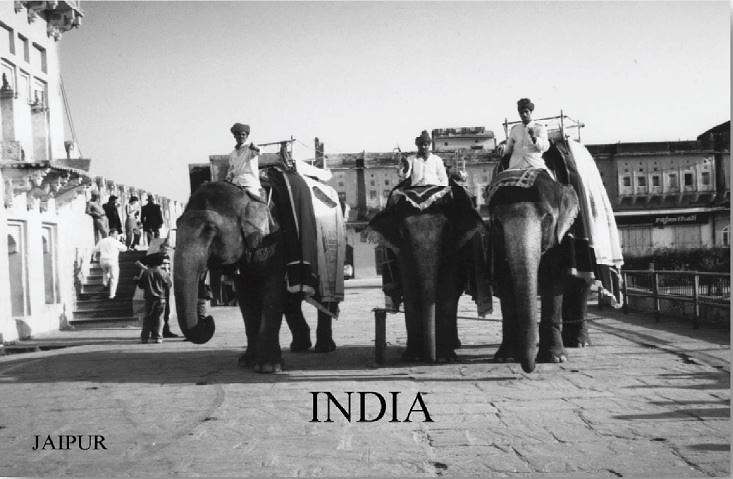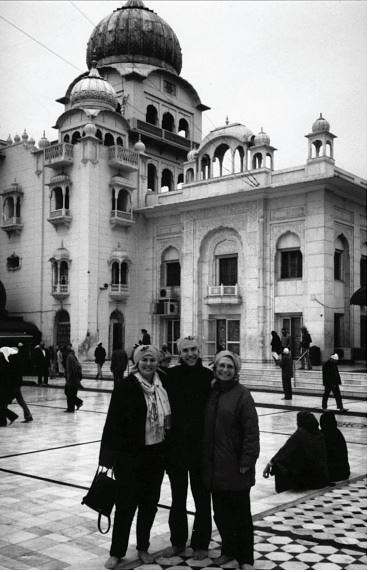
January 2004
My son Selim and I, along with five Belgians, flew from Brussels to Delhi via Vienna on Austrian Airlines. The morning after our arrival our small group traveled by van to Jaipur, the capital of Rajasthan in northern India.
Going through the gates of this old city was an assault on the senses. The density of the people, the poverty on the streets, and the chaotic scramble of cars, trucks, camel carts, rickshaws, and pedestrians all trying to move without any traffic lights or police created an incredible panorama. Car horns honked incessantly on congested roads, where traffic is supposed to move on the left side. The smell of diesel fuel in the air mixed with the aromas of spicy foods on vendors’ carts. A few cows rested in the middle of traffic circles, while others joined pigs and dogs rummaging through trash strewn on street corners.
Dark-skinned women dressed in deep magenta, purple, green, and red saris and selling saffron-colored flower garlands stood out with great beauty amidst the urban squalor. As soon as we stepped out of our van to look at the Palace of the Winds (Hawa Mahal), we were surrounded by beggars, snake charmers, and street urchins trying to sell postcards and trinkets of every kind.
The squalor continued all the way to our hotel. Sidewalks were people’s homes. This is where they cooked, slept, and adorned themselves in colorful fabrics and jewelry. As we drove by, I watched young girls fixing their hair in handheld mirrors. As I admired their human dignity, I wondered how dull westerners must look to them in their black or blue jeans.
Arriving at our five-star hotel, literally around the corner from where street people lived, was an unbelievable contrast. The Rajputana Sheraton offered all the amenities of a luxury hotel, including a choice of restaurants — Indian, Chinese, and continental. While this setting was a welcome respite, it also restricted us from walking beyond its walls. India has many wealthy people, but they must live in well-guarded places.

Drawing water from the well

At the Sikh temple
Traveling between cities, we averaged about 40 km/hour on rural roads, which allowed frequent stops as we encountered scenes unusual to the western eye, such as women carrying water jugs on their heads, or sacred sites. On the way to Agra, one such stop was the Birla Temple, an all white marble structure where adherents of the Jain religion worship. We also stopped at Fatehpur Sikri (City of Victory), built by Emperor Akbar in 1571 as the cultural, commercial, and administrative center of Mughal Dynasty. The city was abandoned fourteen years later when Akbar was called to defend the northwest frontier of his empire. His court followed him; he never returned, leaving the city a perfect ghost town with splendid buildings.
Agra is the home of the Taj Mahal (Crown Palace). Shah Jehan built this mausoleum in memory of his wife Mumtaz Mahal. The entire building is made of marble and inlaid with semiprecious stones. Its shimmering facade changes color depending on light conditions and the time of day.
Outside of Delhi, we visited a Sikh temple. Sikhs are vegetarians and do not kill any animal or plant. They do not eat root vegetables, because pulling them out of the ground would kill the plants. Likewise, they do not wear leather. Those of us with leather shoes had to take them off to enter the temple.
Our brief visit to Delhi, the capital of India, centered on the new city built by the British. Wide avenues, the President’s Palace, the Parliament building, and the India Gate are emblems of New Delhi. Our first sightings of traffic police and traffic lights were here. We arrived just before Republic Day. We watched workers decorate the path to the President’s Palace with colored crushed rocks. Women filled the buckets and carried them on their heads. Men helped scatter the rocks. Women doing hard labor are a common sight in India. The literacy rate among women is under 10%.
